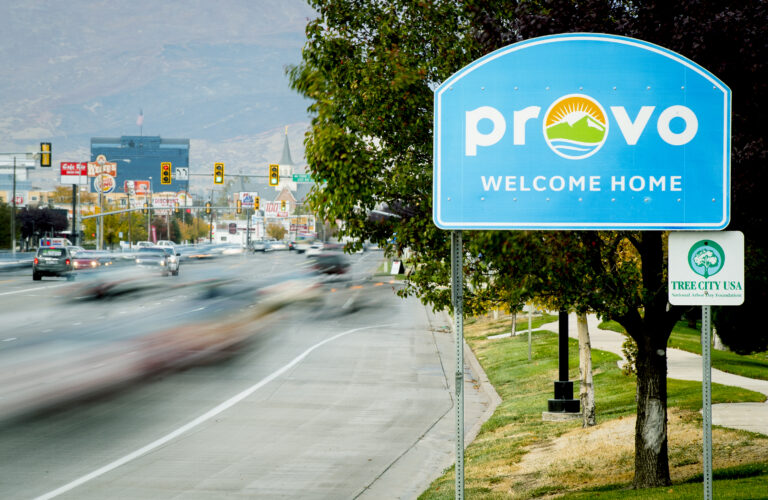Provo Municipal Council addresses Neighborhood Program structure

Isaac Hale, Daily Herald file photo
Traffic streams along University Avenue in Provo on Friday, Oct. 23, 2020.On Nov. 16, the Provo Municipal Council addressed one of the conundrums of the city – what to do with the Neighborhood Program.
The Neighborhood Program Review Committee gave a presentation with the desire to receive a 30,000-foot look at a group of ideas for restructuring the Neighborhood Program.
Provo has 34 individual neighborhoods and it is often difficult to find volunteers to serve as chairs. There is also inconsistency in elections, meetings, function of individual neighborhoods and more, according to the committee findings.
The committee reviewed the current function of the Neighborhood Program, as well as its history. They met with several neighborhood chairs, community partners, city staff, matching grant coordinators and other neighborhood programs across the country.
Provo City’s Neighborhood Program was established in 1968, several years after being discussed in the April 27, 1965, edition of the Daily Herald. When it started in 1968, the neighborhood program was established to provide representative and functional neighborhood committee structures in 19 areas.
In 1972, a program was launched to coordinate recreational activities in each neighborhood. By 1975, the number of neighborhoods was expanded to 24 and a list of 14 suggested objectives and activities were developed. BYU was added as a 25th neighborhood in 1976, according to city historical information.
The Neighborhood Program first appeared in the Provo City Code after approval by the City Commission on Aug. 29, 1978.
“It created a Neighborhood Advisory Board with one representative from each of the five Area Councils to be elected by the Neighborhood Chairs in that area. The purpose was to accommodate local problems and needs, to provide each neighborhood a direct line of communication between the Neighborhood Chair and the City Commission, and to hold local meetings,” said Karen Tapahe, staff manager of the program.
The Neighborhood Program was initially under the direction of the Planning Commission, and the neighborhood chairs were appointed by the mayor. Responsibility later shifted to a coordinator in the mayor’s office.
In 1993, the program was turned over to the Municipal Council as designated by ordinance. Vice chairs, or co-chairs, were appointed by the neighborhood chair prior to 2000. It was changed in the ordinance to an election process. In 1996, the matching grant fund program was implemented for projects focused on neighborhood improvement, city information said.
The term of a neighborhood chair has gone back and forth between two and four years and is currently a four year term. Over the years, quite a few people involved in the Neighborhood Program have gone on to be on various city boards and commissions, as well as the Municipal Council.
The Neighborhood Program was given these top three priorities in the beginning:
- Build community by improving the networks of relationships among people who live and work in the neighborhood and community working together to improve the neighborhood.
- Foster civic engagement and investment.
- Advise the Council on neighborhood needs and allocation of resources (neighborhood visioning).
The large number of neighborhoods — now 34 — leads to a heavier burden on staff as well inconsistency in neighborhood performance. Committee members would like to elevate the Area Council structure of the Neighborhood Program.
The three proposals the council considered for a new code include:
- Switching from a focus on 34 individual neighborhoods to 5 area groups.
- Appoint, rather than elect, each area’s representative. Neighborhoods would still vote for chairs and vice chairs.
- Gather input on land use applications through Open City Hall and other means (neighborhood meetings optional).
While discussion was mostly favorable with the new proposals, Council chairman Dave Sewell was not in agreement.
“I feel like we’re are ending the program with this proposal,” Sewell said. He mentioned having the executive branch or administration take over the program in hopes for an increase in efficiency.
Sewell is not the only one concerned about the council’s direction. Current and former neighborhood chairs are weighing in on the issue and asking for public discussion to be held about the program.
Councilman Travis Hoban said, “Supporting this isn’t saying this is what we want, but that we’re moving in the right direction.”
The council voted 6-1, with Sewell the only one against, for the committee to refine language for a code that the city council could then discuss at a deeper level.
In the meantime, it is anticipated the changes proposed to the Neighborhood program will be vetted through public meetings and open houses.



